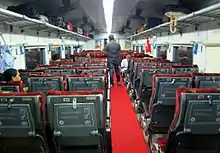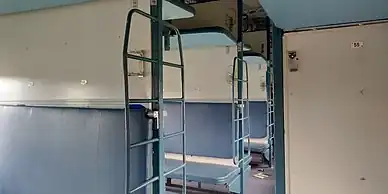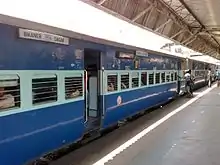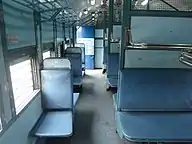Indian Railways coaching stock
Indian Railways offers various travel classes on their coaches. Depending upon their travel class, the passenger cars feature different seating arrangements or berths subject to availability.
Coaches
The following table lists combinations of class-accommodations in normal operation.
| Class[1] | Image | Description[2][3] |
|---|---|---|
| 1A | Exterior Compartment Coupe |
AC first class: The most luxurious and expensive class of Indian Railways, with fares almost at par with airfares. There are eight cabins (including four or five coupes) in full AC first class coach and three cabins (including one coupe) in the half AC first class coach. The coach has an attendant, and bedding is included in the fare. This air-conditioned coach, present only on popular routes, can carry 18-24 (full coach) or 10 passengers (half coach). Each compartment has a door which passengers can lock from inside and there are no side upper or side lower berths in 1A coaches. Compartment having 2 berths (1 lower + 1 upper) are called coupe and compartments with 4 berths (2 lower + 2 upper) are called cabin.[4][5] |
| 2A | AC two tier: These air-conditioned coaches have sleeping berths across eight bays. Berths are usually arranged in two tiers in bays of six: four across the width of the coach and two lengthwise across the corridor, with curtains along the corridor. Bedding is included in the fare. A coach can carry 48 (full coach) or 20 passengers (half coach). | |
| 3A | Exterior Interior |
AC three tier: Air-conditioned coaches with 64 sleeping berths. Berths are similar to 2A, but with three tiers across the width and two lengthwise for eight bays of eight. They are slightly less well-appointed, usually with no reading lights or curtains. Bedding is included in the fare. |
| 3E | AC three tier (economy): Modernised Air-conditioned coaches with sleeping berths. Berths are usually arranged as in 3A,with two tiers across the width and three lengthwise. Appointments are similar to 3A, and bedding is included. These coaches are introduced recently and are increasing in number as such are present only in few trains right now. | |
| EA | Exterior Interior |
Anubhuti: Air-conditioned top-end class of Shatabdi Express, each seat with own in-flight type TV entertainment set. These coaches were introduced on 12 January 2018. First train to get these coaches is Chennai Central–Mysuru Shatabdi Express. |
| EC | Executive chair car: An air-conditioned coach with spacious seats and legroom. With four seats in a row, it is used for intercity day travel and is available on the Tejas, Shatabdi, Double Decker and Vande Bharat Express trains with further different variations. | |
| CC | AC chair car: An air-conditioned coach with five seats in a row, used for intercity day travel. Old model coach is in 3+3 type configuration new model coaches are in 3+2 type configuration.
Air-conditioned double-deck coaches are used on the Double Decker Express, these coaches have 2 decks(upper deck and lower deck(with 3+2 seating configuration)) while Normal CC coach contains only one deck. | |
| SL | Interior (ICF Rake) |
Sleeper class: The sleeper class is the most common coach on IR, with ten or more SL coaches attached to a train rake. Each coach has 9 bays. There are sleeping coaches with 6 (3+3) berths across the width and 2 (1+1) lengthwise in every bay, without air-conditioning. They carry 72 passengers per coach (Increased to 80 in some of the trains like Telangana Express - 12724). There are 4 shared toilets per coach, 2 (1+1) on each end. |
| 2S | Second seater: Similar to CC, without air-conditioning. Double-deck second seaters are used on the Flying Ranee. | |
| UR/GEN/GS | Exterior Interior |
Unreserved/General: The least-expensive accommodation, with a seat not guaranteed. Tickets are valid on any train on a route if used within 24 hours of purchase. |
| Saloon | IR has started to operate saloon coaches to give hotel ambience on trains. These coaches operate on charter basis i.e. booking is required. These have a master bedroom, one normal bedroom, one kitchen and window trailing. Four to six extra beds are given to accommodate more people.[6] First of these coach was attached to Jammu Mail 29 March 2018.[7] | |
| Vistadome | IR operates Vistadome glass roof coaches on select tourist routes. As of February 2022, 45 trains on various routes were equipped with these coaches.[8] Fares are equivalent to AC Executive Chair Car. IR has plans to introduce these coaches in all Mountain railways of India.[9] |
Classification of berths and seats
Berths are classified as follows:
- LB = Lower Berth.
- MB = Middle Berth.
- UB = Upper Berth.
- SL = Side Lower Berth.
- SM = Side Middle Berth.
- SU = Side Upper Berth.
Seater train coaches have no berths, and only the seater coaches(EA, EC, CC, 2S) are classified into three types, which are:
- WS = Window Side
- M = Middle (only in CC and 2S)
- A = Aisle
Middle and Aisle seats are not mentioned in the train ticket. Only Window Side (WS) seats are mentioned in the ticket.
These sitting arrangements are applicable also for Double Deck coaches.
Gallery
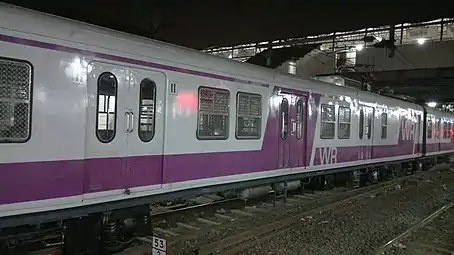 EMU Non AC Coaches of Mumbai Suburban Railway
EMU Non AC Coaches of Mumbai Suburban Railway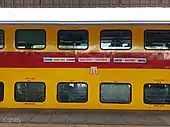 AC Double Decker Coach
AC Double Decker Coach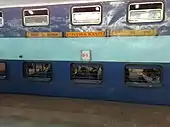 Non AC Double Decker Coach
Non AC Double Decker Coach Pantry Car of Vasco–Chennai Express
Pantry Car of Vasco–Chennai Express Railway Mail Service Coach of Saurashtra Mail Express
Railway Mail Service Coach of Saurashtra Mail Express Train Manager (Guard) and Physically disabled persons Coach
Train Manager (Guard) and Physically disabled persons Coach
See also
References
- "Accommodation Classes in Indian Railways". Indian Railways. Archived from the original on 26 April 2017. Retrieved 26 April 2017.
- "General Information on travelling by IR". IRFCA.org. Indian Railways Fan Club. Retrieved 3 June 2007.
- "Class of Travel". indiarail.co.uk. S.D. Enterprises Ltd. Archived from the original on 13 May 2007. Retrieved 3 June 2007.
- Gayatri, Hema (9 March 2023). "What is Coupe in Train? How to Book, Charges & Availability". Sarkari Result 2023. Retrieved 9 March 2023.
- "Indian Railway Classes: AC (1A,2A,3A), Sleeper (SL) & Seating (EA,EC,CC, 2S)". www.trainman.in. Retrieved 10 July 2022.
- Saloon Coaches
- Saloon attached to Jammu Mail
- "Status of Vistadome Trains". pib.gov.in. Retrieved 9 July 2022.
- "All mountain railways in India to have vistadome coaches: Piyush Goyal". mint. 8 March 2019. Retrieved 9 July 2022.



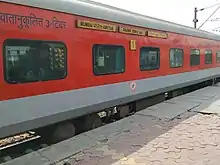
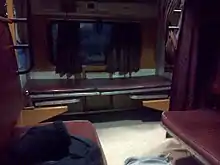


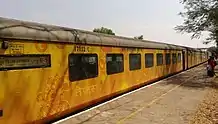


_in_a_Shatabdi_Express.JPG.webp)
